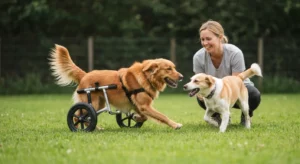WASHINGTON D.C. — A sweeping new federal law, the Canine and Feline Responsible Breeding Act of 2025 (CFRBA), signed into law this week, is set to fundamentally reshape the pet breeding industry across the United States. Taking effect January 1, 2026, the legislation introduces the most stringent national standards for breeder accountability and animal welfare to date, targeting the problematic practices of commercial breeding operations, often referred to as “puppy mills,” while establishing a new gold standard for ethical hobby breeders.
The landmark bill, which passed with bipartisan support after years of advocacy from animal welfare organizations and veterinary groups, aims to improve the health and well-being of dogs and cats by regulating breeding practices from the genetic level up through the first crucial weeks of an animal’s life. For decades, prospective pet owners have navigated a confusing landscape of state and local laws, making it difficult to distinguish responsible breeders from those prioritizing profit over animal health. The CFRBA seeks to replace this patchwork system with a clear, enforceable federal framework.
The Four Pillars of the Responsible Breeding Act
The Canine and Feline Responsible Breeding Act of 2025 is built on four core principles designed to protect both the breeding animals and the puppies and kittens they produce. Federal officials state the goal is to reduce the number of animals with debilitating genetic conditions and behavioral issues that often lead to relinquishment to shelters.
The central components of the new legislation for pet breeders include:
- A National Breeder Licensing & Registry: The U.S. Department of Agriculture (USDA) is tasked with creating and maintaining a publicly accessible national database of all licensed breeders. To be licensed, breeders must pass regular inspections covering housing, sanitation, and animal care. This registry will allow consumers to verify a breeder’s license and review their inspection history before making a purchase.
- Mandatory Genetic and Health Screenings: The law mandates that all breeding dogs and cats undergo genetic testing for diseases and conditions common to their breed. This includes tests for hip and elbow dysplasia, progressive retinal atrophy (PRA), heart conditions like hypertrophic cardiomyopathy (HCM) in cats, and a panel of other DNA-based tests. The results must be disclosed to potential buyers.
- Welfare Standards for Breeding Animals: The CFRBA places strict limits on the frequency of breeding. A female dog will be limited to a maximum of five litters in her lifetime and no more than one litter in any 12-month period. Similar science-based limits are established for cats. The law also sets a mandatory retirement age for breeding animals.
- Standardized Socialization and Enrichment Protocols: Perhaps the most groundbreaking element is the requirement for a documented socialization program for all puppies and kittens. From three days old, breeders must implement programs like Early Neurological Stimulation (ENS) and later introduce the young animals to a wide variety of sounds, surfaces, people, and environments to build resilience and prevent fear-based behavioral problems.
Experts Weigh In on the Landmark Legislation
The reaction from the veterinary and animal welfare communities has been overwhelmingly positive, with many hailing the act as a monumental step forward for companion animal health. Dr. Anya Sharma, a leading veterinary geneticist at Cornell University’s College of Veterinary Medicine, emphasized the long-term impact of the screening requirements.
“For years, we’ve seen the heartbreak that comes with preventable hereditary diseases. A family brings home a beautiful Golden Retriever puppy, only to discover at a young age it has crippling hip dysplasia that will require thousands of dollars in surgery,” Dr. Sharma explained. “This legislation for pet breeders moves the focus from treatment to prevention. By requiring breeders to screen for these known genetic markers and make the results transparent, we are empowering consumers to choose healthier animals and gradually reducing the prevalence of these conditions within the gene pool.”
Enforcement will be key to the law’s success. Michael Vance, the Director of the USDA’s Animal Care Division, which will oversee the program, addressed these concerns. “The national registry is the backbone of the CFRBA,” Vance stated in a press conference. “It’s not just a list; it’s a tool for accountability. Every licensee will have a public-facing profile with their compliance history. Unlicensed breeding and sales will carry significant federal penalties. We are actively hiring and training a new corps of inspectors to ensure these standards are met, not just on paper, but in the whelping box.”
Beyond physical health, the law’s focus on early-life experiences is being praised by animal behaviorists as a critical component for creating stable, well-adjusted family pets.
“The first eight weeks of a puppy or kitten’s life are a period of immense neurological development. What happens during this time can shape their temperament for life,” said Dr. Elena Rodriguez, a Certified Animal Behaviorist and author of The Resilient Pet. “Requiring breeders to provide structured, positive exposure to new things—the sound of a vacuum cleaner, the feel of grass, gentle handling by different people—is not just a nice idea; it’s a scientific necessity for preventing anxiety and aggression later on. This law effectively makes a foundational understanding of animal behavior a prerequisite for being a breeder.”
What This New Legislation Means for Prospective Pet Owners: An Action Plan
The Canine and Feline Responsible Breeding Act of 2025 is more than just an industry regulation; it is a powerful new toolkit for you, the future pet owner. It provides an unprecedented level of transparency and empowers you to make an informed, ethical choice. However, the law’s effectiveness depends on consumers knowing how to use it. Here is a step-by-step guide on how to leverage this new legislation for pet breeders to find a healthy, happy, and well-socialized companion.
1. Master the National Breeder Registry
Starting in 2026, your first step should no longer be a generic online search for “puppies for sale.” Instead, it should be a visit to the official USDA National Breeder Registry website (which will be linked from the main USDA portal). Here’s how to use it effectively:
- Verify Before You Visit: Before you even contact a breeder, look them up in the registry. Confirm they have a valid, active license. If they aren’t in the database, they are operating outside the law. Do not proceed.
- Read the Inspection Reports: The registry will provide public access to a breeder’s inspection history. Look for any violations, direct or indirect. Note the dates of inspections. A breeder with a long history of clean reports is a strong positive signal.
- Cross-Reference Information: Check that the breeder’s name, kennel name, and location on their personal website or social media match the information in the federal registry. Discrepancies are a major red flag.
2. Become an Expert on Your Breed’s Health Report Card
The law’s requirement for genetic health screenings is your greatest tool for avoiding future heartache and veterinary bills. Do not be shy about asking for these documents—responsible breeders will be proud to share them.
- Do Your Homework: Before you start your search, research the specific genetic conditions common to the breed you are interested in. The Orthopedic Foundation for Animals (OFA) and breed-specific parent club websites are excellent resources. For example, if you want a Labrador Retriever, you should know to ask for OFA certifications for hips and elbows. For a Cavalier King Charles Spaniel, you must ask about screenings for Mitral Valve Disease (MVD) and Syringomyelia (SM).
- Request a Full Copy of the Results: Ask the breeder for a copy of the sire’s (father) and dam’s (mother) health certifications and genetic test results. This should not be a verbal confirmation; you need to see the official paperwork from a reputable lab or organization (like OFA, PennHIP, or Embark).
- Learn to Read the Results: Understand what the results mean. For hip dysplasia, an OFA rating of “Excellent,” “Good,” or “Fair” is passing. For genetic tests, a result of “Clear” or “Non-affected” is ideal. A “Carrier” status for a recessive gene may be acceptable if the other parent is “Clear,” but you should discuss the implications with the breeder and your veterinarian. A breeder who cannot clearly explain the results is a cause for concern.
3. Conduct a “Socialization Interview”
A puppy’s price tag reflects not just its pedigree, but the critical early-life work the breeder has invested. The CFRBA now standardizes this work. Your job is to verify it was done properly.
Ask the breeder specific questions about their socialization program:
- “What specific socialization curriculum do you follow? (e.g., Puppy Culture, Avidog, or your own documented program?)” A good breeder will have a structured plan.
- “Can you describe the puppies’ living environment? Where do they spend most of their time?” The answer should be “in the home,” not a garage or outdoor kennel. They need to be exposed to the daily sights and sounds of a household.
- “What new sights, sounds, textures, and surfaces have the puppies been exposed to this week?” Listen for specific examples: car rides, the sound of a washing machine, walking on carpet, tile, and grass, meeting a cat, etc.
- “How many different people (of varying ages and appearances) have the puppies met?” Early, positive interactions with a variety of humans are crucial.
- “How do you handle ‘fear periods’ or a puppy that seems shy?” A responsible breeder will have a strategy for confidence-building, not punishment or dismissal.
4. Verify the Well-being of the Mother (Dam)
The new law protects the mother dogs and cats from the exhaustive cycle of over-breeding seen in puppy mills. A healthy, well-cared-for mother is essential for raising healthy, stable offspring.
- Ask to Meet the Mother: When you visit, always ask to see the mother with her litter. Observe her temperament. Is she friendly, confident, and relaxed, or is she nervous, fearful, or aggressive? Her temperament is a strong indicator of her puppies’ potential disposition.
- Inquire About Her Breeding History: Politely ask how old she is and how many litters she has had. Under the CFRBA, this information must be tracked. A breeder who is transparent and operating within the legal limits (e.g., this is her second litter and she is four years old) will have no problem answering. Hesitation or vagueness is a red flag.
- Assess Her Condition: The mother should be in good physical condition—a healthy weight, a clean coat, and engaged with her puppies. She should not appear exhausted, emaciated, or unkempt.
5. Confirm the Microchip at Your First Vet Visit
The CFRBA’s mandatory microchipping provision provides a permanent link between the puppy and its breeder, ensuring traceability and accountability. This is a critical final step in your purchasing process.
- Get the Microchip Number: The breeder must provide you with the puppy’s microchip number and the paperwork from the microchip company.
- Scan and Verify: Within 72 hours of bringing your new pet home, take them to your veterinarian for a wellness check. Ask the vet to scan for the microchip and verify that the number matches your paperwork.
- Register Immediately: The most important step is to immediately go online and register the microchip in your name with your contact information. A microchip is useless until it is registered to the current owner. This simple act is your pet’s best chance of being returned to you if they ever get lost.
The Canine and Feline Responsible Breeding Act of 2025 marks a new era in animal welfare. By understanding its provisions and using them as your guide, you are not only selecting a healthier companion for your family but also casting a powerful vote for ethical breeding and helping to put an end to the cruelty of puppy mills for good.












